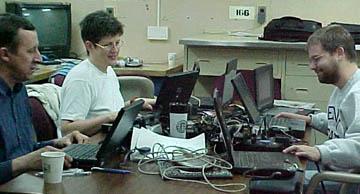27 March, 2001
Tidbit of History
Until the beginning of the 19th century, there was little uniformity as to
the meridian from which longitude was measured. The navigator was not
parcticularly concerned, as he could not determine longitude anyway. The
meridian of London was used as early as 1767 and over the years its
popularity grew as England's maritime interests increased. The system of
measuring longitude both east and west through 180 degrees may have first
appeared in the middle of the 18th century. Toward the end of the century,
as the Greenwich Observatory increased in prominence, English mapmakers
began using the meridian of that observatory as a reference. A later and
unsuccessful attempt was made in 1810 to establish Washington D.C. as the
prime meridian for the Americas. At an international conference held in
Washington in 1884 the meridian of Greenwich was officially established as
the prime meridian by the 25 nations in attendance.
Science Observations
Latitude lines indicate north and south. Longitude lines indicate east and
west. There are 60 miles between each latitude degree however, there is no
uniform distance between longitudinal degrees. The lines get closer
together as one approaches the north and south poles. The Arctic Circle is
66.5 degrees north. We began out science research at 62 degrees. The
northernmost latitude point was 63 degrees 17 minutes. This happened to be
along the International Date Line. We went as far west as175 degrees 17
minutes. Here again we were traveling along the International Date Line.
The furthest east was 170 degrees 37 minutes. This is closest station to
the Alaska coast.
The total nautical miles traveled thus far from Seattle (where the ship
deployed) to Dutch Harbor is 3400 miles. Dutch Harbor is approximately 4200
miles from Knoxville. St. Lawrence Island is 545 miles from Dutch Harbor or
a 3-day steam by ship. The Polar Star will begin to head back toward Dutch
Harbor by noon on April 2. I will be leaving the ship on April 1, coming
home by a different route. Any way you look at it, we have traveled a lot
of miles!!!
Daily Update
Tonight I will be giving the guest lecture on my role as the "resident
teacher" aboard ship. My talk will focus on the TEA program and the effect
that it has and will continue to have on my classroom and teaching. I will
share a power point presentation and the iMovie that I developed of my
children's work. (The iMovie can be opened on the first page of my TEA
site.)
Today two stations were completed on my shift and work seemed to be getting
back to a regular schedule. The temperatures have warmed up and the wind
isn't blowing nearly as hard. Helo OPS were resumed. It was a beautiful
day to fly. Few mammals were spotted; however, I did see an adult walrus on
the ice in front of the ship during the helo take-off. It stayed on the ice
floe for quite a while before diving under water hunting for clams I
imagine.
Plans are underway for my departure from the ship. I am planning to helo
off the ship on Sunday, April 1 headed for Gambell, a native community on
St. Lawrence Island. From there I will travel to Nome and on to Little
Diomede weather permitting. Please refer to the TEA webpage for email
address change. It will be constantly updated.

<> Computer work in the science library.
Contact the TEA in the field at
.
If you cannot connect through your browser, copy the
TEA's e-mail address in the "To:" line of
your favorite e-mail package.
|
